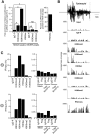The comprehensive epigenome map of piRNA clusters
- PMID: 23258708
- PMCID: PMC3561999
- DOI: 10.1093/nar/gks1275
The comprehensive epigenome map of piRNA clusters
Abstract
PIWI-interacting RNA (piRNA) clusters act as anti-transposon/retrovirus centers. Integration of selfish jumping elements into piRNA clusters generates de novo piRNAs, which in turn exert trans-silencing activity against these elements in animal gonads. To date, neither genome-wide chromatin modification states of piRNA clusters nor a mode for piRNA precursor transcription have been well understood. Here, to understand the chromatin landscape of piRNA clusters and how piRNA precursors are generated, we analyzed the transcriptome, transcription start sites (TSSs) and the chromatin landscape of the BmN4 cell line, which harbors the germ-line piRNA pathway. Notably, our epigenomic map demonstrated the highly euchromatic nature of unique piRNA clusters. RNA polymerase II was enriched for TSSs that transcribe piRNA precursors. piRNA precursors possessed 5'-cap structures as well as 3'-poly A-tails. Collectively, we envision that the euchromatic, opened nature of unique piRNA clusters or piRNA cluster-associated TSSs allows piRNA clusters to capture new insertions efficiently.
Figures



Similar articles
-
piRNA clusters as a main source of small RNAs in the animal germline.Biochemistry (Mosc). 2013 Jun;78(6):572-84. doi: 10.1134/S0006297913060035. Biochemistry (Mosc). 2013. PMID: 23980884 Review.
-
Transgenerationally inherited piRNAs trigger piRNA biogenesis by changing the chromatin of piRNA clusters and inducing precursor processing.Genes Dev. 2014 Aug 1;28(15):1667-80. doi: 10.1101/gad.245514.114. Genes Dev. 2014. PMID: 25085419 Free PMC article.
-
A role for transcription from a piRNA cluster in de novo piRNA production.RNA. 2012 Feb;18(2):265-73. doi: 10.1261/rna.029777.111. Epub 2011 Dec 22. RNA. 2012. PMID: 22194309 Free PMC article.
-
Long first exons and epigenetic marks distinguish conserved pachytene piRNA clusters from other mammalian genes.Nat Commun. 2021 Jan 4;12(1):73. doi: 10.1038/s41467-020-20345-3. Nat Commun. 2021. PMID: 33397987 Free PMC article.
-
piRNA biogenesis in the germline: From transcription of piRNA genomic sources to piRNA maturation.Biochim Biophys Acta. 2016 Jan;1859(1):82-92. doi: 10.1016/j.bbagrm.2015.09.002. Epub 2015 Sep 5. Biochim Biophys Acta. 2016. PMID: 26348412 Review.
Cited by
-
piRNAs derived from ancient viral processed pseudogenes as transgenerational sequence-specific immune memory in mammals.RNA. 2015 Oct;21(10):1691-703. doi: 10.1261/rna.052092.115. Epub 2015 Aug 17. RNA. 2015. PMID: 26283688 Free PMC article.
-
An ancient transcription factor initiates the burst of piRNA production during early meiosis in mouse testes.Mol Cell. 2013 Apr 11;50(1):67-81. doi: 10.1016/j.molcel.2013.02.016. Epub 2013 Mar 21. Mol Cell. 2013. PMID: 23523368 Free PMC article.
-
What Are the Functional Roles of Piwi Proteins and piRNAs in Insects?Insects. 2023 Feb 14;14(2):187. doi: 10.3390/insects14020187. Insects. 2023. PMID: 36835756 Free PMC article. Review.
-
Annotation of piRNA Source Loci in the Genome of Non-model Insects.Methods Mol Biol. 2025;2935:125-139. doi: 10.1007/978-1-0716-4583-3_6. Methods Mol Biol. 2025. PMID: 40828277
-
Mitochondrial protein BmPAPI modulates the length of mature piRNAs.RNA. 2013 Oct;19(10):1405-18. doi: 10.1261/rna.040428.113. Epub 2013 Aug 22. RNA. 2013. PMID: 23970546 Free PMC article.
References
-
- Slotkin RK, Martienssen R. Transposable elements and the epigenetic regulation of the genome. Nat. Rev. Genet. 2007;8:272–285. - PubMed
-
- Klattenhoff C, Theurkauf W. Biogenesis and germline functions of piRNAs. Development. 2008;135:3–9. - PubMed
-
- Ronsseray S, Josse T, Boivin A, Anxolabehere D. Telomeric transgenes and trans-silencing in Drosophila. Genetica. 2003;117:327–335. - PubMed
Publication types
MeSH terms
Substances
LinkOut - more resources
Full Text Sources
Miscellaneous

